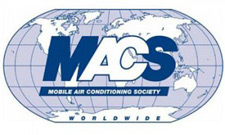Air conditioning’s main principles are:
-
Evaporation and Condensation
-
Compression and Expansion

The fluid that passes around the whole system is the refrigerant. The refrigerant can evaporate at a low temperature, and then condense again at a higher pressure. We use R- 134 A for gassing.So, here is how all the various parts of a car’s air conditioning works:
Compressor: The compressor is the main part of the air conditioning system, powered by a drive belt connected to the crankshaft of the engine. When the air-conditioning system is turned on, the compressor pumps refrigerant vapor under high pressure to the condenser.
Condenser: The condenser is a device used to change the high-pressure refrigerant vapor into liquid. It is mounted in front of the engine’s radiator, and it looks very similar to a radiator. The vapor is condensed to a liquid and this generates a great deal of heat. The heat is then removed from the condenser by air flowing through the condenser on the outside.
Receiver – Dryer: At this stage the liquid refrigerant moves to the receiver-dryer. This is a small reservoir vessel for the liquid refrigerant. It removes any moisture that may have leaked into the refrigerant. Moisture in the system causes blockages and mechanical damage.
Expansion Valve: The pressurized refrigerant flows from the receiver-drier to the expansion valve. The valve removes pressure from the liquid refrigerant so that it can expand and become refrigerant vapor in the evaporator.
Evaporator: The evaporator is another device that looks similar to a car radiator. It has tubes and fins and is usually mounted inside the passenger compartment behind the fascia above the foot well. As the cold low-pressure refrigerant is passed into the evaporator, it vaporizes and absorbs heat from the air in the passenger compartment. The blower fan inside the passenger compartment pushes air over the outside of the evaporator, so cold air is circulated inside the car.
Blower: The blower inside the vehicle is use to blow air over the evaporator. This cools the air which is then blown from the vents.








